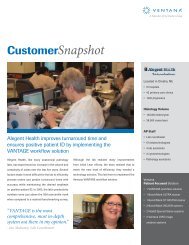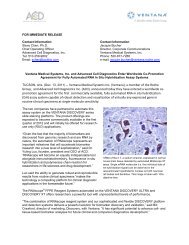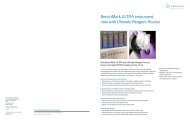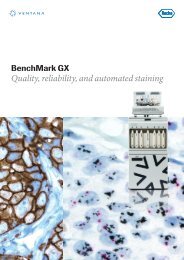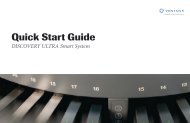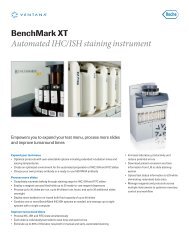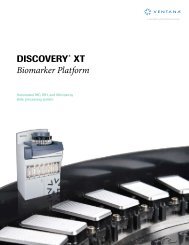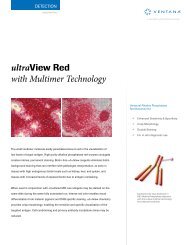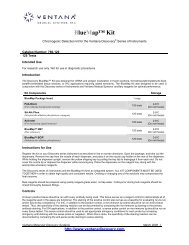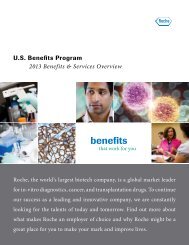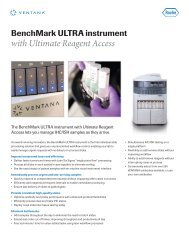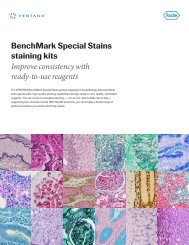Case Study - Ventana Medical Systems
Case Study - Ventana Medical Systems
Case Study - Ventana Medical Systems
- No tags were found...
You also want an ePaper? Increase the reach of your titles
YUMPU automatically turns print PDFs into web optimized ePapers that Google loves.
<strong>Case</strong> <strong>Study</strong>Leadership change builds foundation forimplementation of Lean Six SigmaPhysicians Reference Lab sustains quality in high growth market
<strong>Case</strong> <strong>Study</strong>Leadership change builds foundation for implementation of Lean Six SigmaPhysicians Reference Lab sustains quality in high growth marketTable of ContentsI. BackgroundII. Preparing for Lean Six SigmaIII. Staffing for SuccessIV. Lessons Learned from Staffing Re-alignmentV. Cross-trained Technicians Create a More Flexible LabVI. Hands-on Supervisors Improve Workflow and MoraleVII. Next StepsVIIl. SummaryImproving and sustaining quality during peak growth isa formidable challenge. Recognizing this, the leadershipat Physicians Reference Laboratory (PRL), Kansas City’slargest private reference lab, took a critical look at theorganization’s strengths and weaknesses. This internal analysisled to improvements in operations, workflow, staffing and—most importantly—attitude.Today, PRL leaders no longer believe growth is daunting.They know it is the natural and welcome result oftheir organization’s journey to high performance. After ayear of reflection and reorganization, PRL is primed forimplementation of Lean Six Sigma methods as a means toaccelerate improvement in quality, productivity, efficiency andpatient safety.l. BackgroundDuring 2008 performance reviews for PRL pathologists, acommon theme emerged: Quality, work distribution andstaff attitude in the histology lab were inconsistent. “As thelargest private histology lab in the city, we lacked the internalstructure, quality measures and automation necessaryfor future growth,” lamented Paul Munyer, M.D., Ph.D.,director of anatomic pathology.While PRL’s quality consistently met or exceeded industrystandards, the organization was concerned thatthey didn’t have systems in place to ensure a high level ofquality as they grew. Leadership called for change. “Werealized we needed to build a stronger infrastructure withgreater supervisory capacity to suport our growth goals,”explained Dr. Munyer.PRL leadership looked to past successes for solutions. In2006, the PRL clinical testing laboratory had implemented amajor Lean Six Sigma re-engineering project, achieving exceptionalresults. It was clear that a similarchange was needed for anatomic pathology.In early 2009, Spencer Kerley,M.D., chief executive officer, empoweredthe chief operations officer26%and director of anatomic pathologyto begin a re-engineering project foranatomic pathology.ll. Preparing for Lean Six Sigma<strong>Ventana</strong> <strong>Medical</strong> <strong>Systems</strong>, Inc., was brought in to conducta comprehensive assessment and identify opportunitiesfor using Lean Six Sigma strategies to improve andstandardize laboratory performance. <strong>Ventana</strong>, with PRLleadership, determined that before a major re-engineeringproject could be launched, staff morale and productivityneeded to improve. PRL leadership made the toughdecision to replace the current anatomic pathologymanager. “Initially staff and senior pathologists met thisdecision with a modicum of hostility and bewilderment,”admitted Dr. Munyer. “But acceptance mounted as webegan to solicit input and established an ‘open door’ policyto privately discuss issues that otherwise would have beenleft unaddressed.”The PRL leadership team re-grouped staff into three areas:histology, transcription and cytology. They scheduled informaltown hall meetings with each group to gather ideas andgarner support for the re-engineering project. “We created2 of 5 April 2010
Organizational Chart (After)DirectorOrganizational Chart (Before)DirectorSupervisorSupervisorSupervisorSupervisorManagerLeadsa safe environment for information sharing and developedcohesion among the staff“, said Dr. Munyer. “A sense of trustemerged. Although some staff remained skeptical, the majorityseemed eager to move forward.”Leadership accelerated the project with quick initialwins. Small victories, such as installation of computeraccessories and upgrades, increased communication, and redefinitionof job descriptions, became a springboard to acceptanceof the more critical task of re-aligning staff.lll. Staffing for SuccessDuring these early changes, the daily workload continuedto increase. The histology lab operated for approximatelyfour months without direct supervision, although theanatomic pathology director assumed some supervisoryresponsibilities.As PRL worked to recruit a new histology supervisor, leadershipshadowed various positions within the histology lab,observing day-to-day operations, staffing, workload and workflow.PRL leaders quickly determined that staffing levels andworkload were mismatched. Industry benchmarks and internalpeak/valley workload patterns revealed that the lab was overstaffed.PRL eliminated part-time lab assistant positions, creatinga lab staffed entirely with histotechnologists.Staffing-to-workload ratios were subsequently presentedto histology staff at a town hall meeting. Based on the data,leadership asked histology staff to re-apply for their currentpositions. This was to encourage tenured techs to emergeas potential lead techs and create a more streamlined staffingmodel. In addition, leadership wanted the right numberof full-time employees in the right roles with true performanceaccountability.The director of human resources created a comprehensiveand impartial scoring system for evaluating staff. Eachemployee within the histology section re-interviewedfor his or her position. PRL leadership assessed educationalbackground, technical experience, trainability, teamattitude and interpersonal skills. Candidates were thencompared to one another based on the performancemeasures. “The result was somewhat surprising. Some technicallygifted employees scored low on team attitude. We hadconcluded that poor attitude was contributing to inefficiencies,so we rewarded team players and released some of our highlyskilled staff,” explained Dr. Munyer.IV. Lessons Learned from Staffing Re-alignmentStaffing re-alignment is both difficult and rewarding. It came asno surprise to PRL leadership that staff changes were oftenmet with resistance. However, acceptance sometimes came inunexpected situations.For example, after one long-tenured employee’s position waseliminated, she actually thanked leadership. “She told us theprocess had been fair and impartial; it allowed her to see thatshe was not comfortable working with automated technologies,”said Dr. Munyer. “She acknowledged that she was nolonger the ‘right person’ in a role she had held for many years.That was a true testament to the process we had engaged.”3 of 5 April 2010
Candidate Evaluation and Comparison FormsCandidate Evaluation Criteria370HT - HistotechnologistExperiencePerformanceAssessmentTrainabilityTeamworkSkillsInterpersonalSkillsCandidate Name: _____________________________Interviewer: __________________________________Below Average Average Above Average Exceptional1 2 3 4 Weight Totalx _____ =x _____ =x _____ =x _____ =x _____ =Grand TotalComments ________________________________________________________________________________________________________________________________________________________________________________________________________________________________________________________________________________________________________________________________________________________________________________________________________________________________________________________________________________________________________out ofexplained Marty Mroz, director of human resources. HumanResources purposefully filled gaps with workers who hada positive outlook on the changes that were occurring. Inaddition, leadership scheduled frequent meetings to givestaff a venue to connect and share, reinforcing newfoundunity. Attitudes and the overall atmosphere of the lab changeddrastically.Empowering frontline staff to participate in decisions andmake improvements is critical to successful re-alignment.During the hiring process, PRL leadership asked staffto help define the future role and responsibilities of thesoon-to-be recruited histology supervisor. The teaminsisted that their new leader be an experienced histotechnologistwho could provide a fresh perspective on PRL operations.Staff envisioned a histology supervisor who had the skillsto fill in when needed and could also be an effective leader,coach and mentor. “We recognized it would not be easy tofind someone who could simply step into a busy lab and hitthe ground running. But we were determined to take the necessarytime to find the right individual,” explained Dr. Munyer.Candidate Comparison370HT - HistotechnologistV. Cross-trained Technicians Create a MoreFlexible LabEmployeeExperiencePerformanceAssessmentInterviewers ______________________TrainabilityTeamworkInterpersonalSkillsTotal0.00.00.00.00.00.00.00.0%Historically, most techs at PRL were confined to performinga single task. With the new, leaner staffing model, techs werecross-trained in all areas of the lab to fill gaps and removebottlenecks. The techs quickly adapted to the new mindset.“We monitor the lab to identify where flex staffing is needed,”said Donna Millard, histology supervisor. For example, if a backlogof trays are waiting to be sectioned, an embedder movesto sectioning, even though there may still be blocks left toembed. If sectioning catches up, that same person may moveback to embedding. Techs performing special stains areexpected to multi-task and may section, embed or help withcase assembly while waiting on a stain. When absences occur,any tech can fill in at any station.______________________Doing the same amount of work with a smaller staff isnever easy, but employees rally together to fill gaps whennegative influences are removed. After the histologysupervisor and the employees exhibiting poor attitudeswere dismissed, the lab became a more cohesive unit.“We learned that the culture shock that comes with staffingchange needs to be tempered with individuals whoare enthusiastically committed to seeing it through,”Vl. Hands-on Supervisors Improve Workflowand MoraleSuccessful organizations have supervisors who areable to step in and perform work and solve problemsin real time. The addition of a new histology supervisorwho had a solid understanding of operations and staffingprovided an immediate benefit. “I was able to step inat critical times and work side-by-side with the staff whichhelped establish trust and credibility,” explained Millard.“Quite simply, watching a task does not yield the samelevel of understanding that performing the task does,”she added.4 of 5 April 2010
Benefits of Lean Six SigmaProcess Steps Current State Future StateAccessioning 53.6 11.5Grossing 183.7 31.8Tissue Processing 739.8 739.8Embedding 158.6 57.7Microtome 52.6 15.4H&E Staining 66.9 46.3IHC Stainging 426.0 410.8Special Staining 133.1 117.9<strong>Case</strong> Assemble 252.7 188.9Total Time 2067 1620Cycle Time saved25% complete447.0 minutes7.4 hoursA new attitude toward questioning evolved. Staff beganto ask, “Why do we do it this way?” For example, staffused to write instructions on the side of cassettes. The PAsupervisor questioned the practice and discovered thatthis practice was originally established to accommodate anemployee who no longer worked for the company.Staff also generated solutions to inefficiencies in specimenstorage. The PA supervisor, along with the help ofthe gross room staff, streamlined storage that drasticallyreduced time spent looking for specimens.VII. Next StepsPRL realizes that the reorganization of staff and a change inattitude are just the first steps toward Lean Six Sigma improvements.Creating a Lean lab is an on-going project, with multiplephases. Next phases will address lab design and equipmentneeds. PRL is currently evaluating ways to increase productivitywith bar-coding and improved labeling and staining processes.Lab layout re-design is a core component of <strong>Ventana</strong>’s recommendationsfor improvement and growth.PRL is on the path to becoming and maintaining a highlyefficient and productive, metrics-driven, state-of-the-artlaboratory focused on patient care and the core values ofthe organization.The solution is improving communication, not hiring morepeople. In the past, when problems arose or workflow seemedoverwhelming, the PRL solution was to hire more people.Throughout the re-alignment, techs were re-trained to offersolutions to workflow problems. Studies show that the peoplewho are closest to a problem have the greatest insight for aneffective solution. “We learned that good ideas get better withteam input and bad ones often spur others to think creatively,”said Millard.Vlll. SummaryIn the midst of growth, PRL, in partnership with <strong>Ventana</strong><strong>Medical</strong> <strong>Systems</strong>, Inc., conducted a comprehensive Lean SixSigma evaluation and identified realistic opportunities forre-engineering their histology lab to improve and standardizeperformance. A first step was to address staff morale. A qualifiedhistology supervisor was hired and an array of changes—many initiated by staff—were put into action. Improvementswere made in internal structure, staffing, organizational cultureand workflow. As a result, the lab is performing more workwith fewer employees, and PRL now has a strong foundationin place on which to introduce Lean Six Sigma strategies thatwill further streamline processes and improve patient safety.As cross-trained techs worked througout the lab, new ideasemerged. Even small ideas made an impact on the workflowand improved execution time.5 of 5 April 2010
Physicians Reference Laboratory7800 West 110th StreetOverland Park, KS 66210Toll Free: 800-821-3627Local: 913-338-4070www.prlnet.com©2010



